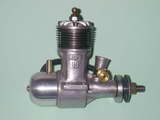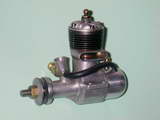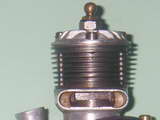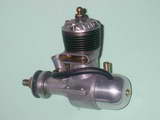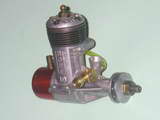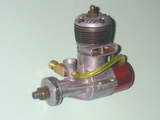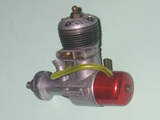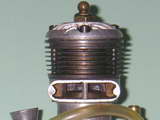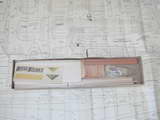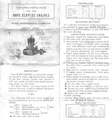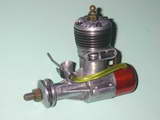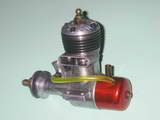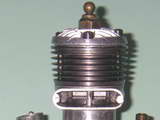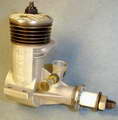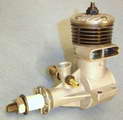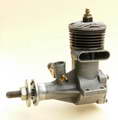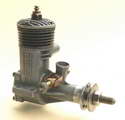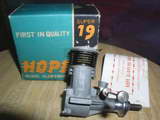A Forgotten Japanese Range:
The Hope Engines
by Adrian Duncan and Alan Strutt
Chapter 4: The Hope .19 cuin Models
Click on images to view larger picture.
Hover over photos for a description.
The Hope 19 models represented one of the more popular displacement categories in the Hope range and probably had a lot to do with the marque surviving as long as it did. Let's take a close look at this series.
The Hope 19—First Model
As we saw in our summary chapter on the Hope range, the earliest presently-documented Hope 19 was a sand-cast glow motor which was most probably added to the range in 1949. There has been one unsubstantiated report to the effect that Hope may have briefly marketed a spark-ignition .19 model prior to this, but we have yet to see any concrete evidence for the existence of such a model.
Sticking with what we do know for sure, the original glow-plug Hope .19 retained the Hope B's crankshaft rotary valve, brush-finished sand-cast aluminium alloy case and screw-in backplate with square-section central boss for mounting a back tank of plain aluminium alloy. In addition, like its larger companion it featured mounting lugs which were set above the axial centre line of the crankshaft.
However, the similarities ended at that point and the design showed considerable progression from that of the Hope B. The cast iron cylinder was completely re-designed, although it retained the integrally-turned cooling fins. These fins were notably thin in section and appear rather vulnerable to damage given the fact that they were formed in the relatively delicate cast iron. The engine featured six of these fins between the upper and lower cylinder flanges, resulting in seven deep cooling "grooves" between the fins (ignoring the shallow groove in the upper cylinder flange).
The most obvious visual difference from the Hope B was the switch from radial porting to the more up-to-date loop scavenging system, together with the abandonment of the blind bore used on the Hope B in favour of a conventional sand-cast alloy cylinder head sealing to the liner with a gasket. The engine featured a left-hand placement of the exhaust stack.
Basically, the new Hope 19 was a completely conventional American-style loop-scavenged glow motor of its time. As with the Hope B, the engine's rather basic appearance and utilitarian external finish belied the fact that the quality of construction was up to the best contemporary commercial standards. In keeping with emerging trends, the new Hope model was an over-square engine having a measured bore and stroke of 16.0 mm and 15.5 mm respectively for a displacement of 3.12 cc (0.190 cuin—clearly, Hope took the 19 designation seriously at this stage!). The checked weight of the first model Hope 19 is 6 ounces even, including tank, plug and fuel tubing.
The Hope 19—Second Model
The original sandcast version of the Hope 19 described above is extremely rare today, indicating that total production was probably relatively small. It would appear that fairly soon after the introduction of this design, a major production change took place at the Hope factory. This was a wholesale switch from sand-casting to die-casting for the cast alloy components. It's impossible to be certain, but this pivotal change most probably dates from 1950.
The taking of this step provides a clear indication that the Hope engines were then selling fairly well in those markets in which they were being promoted at the time. My Japanese contacts inform me that the range was very popular in Japan for some years during the 1950's, and the on-going development of the various models during this period certainly supports this assessment. Clearly, demand had outstripped the ability of the factory to produce the engines and steps had to be taken to increase production. A change to the die-casting process was an obvious move in that direction. It would appear that at this stage the Hope enterprise was a growing concern!
As documented in our chapter on the Hope 29 models, the company flirted with the use of magnesium alloy for the initial version of their contemporary New 29 model. However, this does not appear to have been a success, and we currently have no evidence that a similar material choice was ever applied to the Hope 19.
The die-cast version of the Hope 19 was broadly similar to its sandcast predecessor. The general layout and appearance of the engine remained unchanged, as did the 16.0 mm bore. However, the stroke had now been lengthened slightly to a full 16.0 mm, resulting in a square design having a displacement of 3.22 cc (.196 cuin). This conforms to the figures which appear in the sole Hope instruction leaflet in my possession.
The very thin integral cooling fins were retained but the cylinder of the new model was slightly shorter, with one cooling fin being omitted to accommodate this. The resulting cylinder had only five fins between the upper and lower cylinder flanges, with six deep cooling "grooves".
The die-cast cylinder head featured a rather more rounded profile than its sand-cast predecessor. Another change was the downwards relocation of the mounting lugs to bring the mounting plane onto the axial centre-line of the engine. The new die-cast case was considerably less massive than its sand-cast predecessor, to the point where the bearer spacing and mounting hole configuration of the two models were quite different. Accordingly, the revised .19 could not be interchanged with the sand-cast version in the same model. As a marketing strategy, this approach seems questionable in view of the consequent barrier to direct interchangeability between the earlier model and its replacement.
To restore any lost strength due to the lighter castings, the revised crankcase had a main bearing that was considerably more substantially braced than its predecessor. The die-castings on the revised 19 were left in more or less their as-cast form with only a little clean-up work being done on them. The tank of the revised model was anodized red.
One benefit of the changes in the design was a reduction in weight. The initial die-cast model of this motor weighed in at only 5-5/8 ounces all inclusive.
In this case, we do have one contemporary reference in the form of a short article entitled Motors from Japan which appeared in the January 1953 issue of Aeromodeller magazine but was clearly researched and written in the latter part of 1952 to meet the editorial deadline. This article was based on information regarding then-current Japanese products that had recently been provided to the magazine by a serving Royal Navy officer, Lieutenant DA McNaughton. This officer had just completed a period of active service in Korean waters (the Korean War was then the "hot" conflict of the day).
Lieutenant McNaughton was an aeromodelling enthusiast who had evidently spent some time in Japan or Hong Kong while on leave in the Far East and had acquired several Japanese motors, two of which he loaned to Aeromodeller as subjects for their article. This was reportedly the first opportunity that Aeromodeller staff had ever had to study Japanese engines. They appear to have been quite favourably impressed, rather to their own surprise!
The text of the article focused on the contemporary O.S. New 29 twin-stack and Mamiya .099 models, but an illustration was included which showed a die-cast Hope 19 of the type just described installed in a Keil Kraft "Pacer". This proves beyond doubt that the initial die-cast version of the Hope 19 certainly existed as of 1952 and may well have been introduced earlier, as we have postulated above.
It's clear that by this time the Hope manufacturers were entertaining visions of marketing their engines worldwide, thus emulating their rivals at both Enya and O.S. The instruction leaflets supplied with the engines were printed in very clear English as well as in Japanese, and the sturdy and attractive red and yellow boxes in which the engines were now sold were also printed in English.
The back tank which had been a feature of the Hope 19 and 29 models all along was retained in the new 19, although this component was now anodized red, presumably for greater eye appeal. An externally threaded needle with matching spraybar was also retained in the 19 series. The early models used a brass thimble-style needle like that seen on the companion Hope New 29.
One interesting characteristic of this model (and indeed other Hope models) is the use of dual threads for the hold-down screws. The two short screws on either side of the head which thread into the upper flange of the cast-iron cylinder are conventional 2.5 mm x 0.45 mm metric items, while the two long screws fore and aft which hold the entire cylinder assembly down onto the aluminium case are of an odd coarse-thread variety (2.5 mm x 0.7 mm). This arrangement also appeared on the Hope "New 29" model discussed elsewhere. The use of these different threads was evidently based upon the different materials into which the screws were threaded, the intent being to minimize the possibility of stripping the threads.
The assembly screws are also unusual in having far taller heads than normal, allied to extremely deep slots. A technical suggestion—do not damage or lose the coarse-thread screws if you really must take one of these motors apart! Replacements would be very difficult to find. In any case, as with the Hope "Super" 29 model mentioned in the previous chapter we recommend against dismantling of these engines because re-establishment of the correct cylinder "set" upon re-tightening will be difficult or impossible.
The Hope 19—Third Model
It appears that the very thin cast-iron cooling fins of the first two Hope 19 models must have proved rather vulnerable to damage from accident or mishandling. At some point, likely in 1951, the company took steps to address this issue.
However, before proceeding with a description of this next evolution of the Hope 19 we find it necessary to touch upon a possibly controversial matter. Page 96 of Mike Clanford's A-Z book (to which reference has previously been made) includes a photograph of what appears to be yet another revised version of the Hope 19. The main crankcase casting for this model is a die-casting which looks identical to that of the previously-described variant. However, the cylinder is very different—the integral cooling fins are gone and the cooling jacket is now a separate turning in light alloy.
Despite having made contact with knowledgeable collectors worldwide, I have been unable to find anyone who has seen a duplicate of this engine. If a production run of engines built to this pattern was actually made by the factory, I would expect to have heard reports of at least one or two others. If such examples exist, I'd still like to hear about them, whoever made them! So far, no luck!
In the absence of any such reports, I'm of the opinion that this is far more likely to be a one-off made not by the Hope factory but by the owner of a die-cast Hope 19 like that described previously. The creation of such a version would not be in the least difficult for anyone with a lathe—just turn off the cooling fins (leaving a top flange) to convert the cylinder into a drop-in liner and then make the necessary cooling jacket from light alloy.
But why would anyone do this? I can think of two possible reasons. Firstly, we've noted that the thin integral fins on the cast-iron cylinders of the first two .19 models are very vulnerable to damage from a variety of potential causes. Their replacement by a turned aluminium cooling jacket would be a very practical and quite straightforward fix for a cylinder on which a substantial number of the integral cooling fins had become damaged.
Another possible reason for such a modification is the cylinder stress issue which has been cited previously as a reason not to disturb one of these engines unnecessarily. In the previously-described models of the Hope 19, the stresses imposed by the two main hold-down screws are transmitted to the lower cylinder flange and thence to the case through the very thin cylinder wall. This set-up will inherently tend to result in some degree of distortion of the malleable cast iron cylinder, particularly given the employment of only two stress concentration points at the base of the cylinder. With the use of a separate alloy jacket and the elimination of the integral cooling fins and lower cylinder flange, matters could easily be arranged so that hold-down stresses could be transferred to the case through the jacket, leaving the actual cylinder wall unstressed and distortion-free.
Regardless of the reason for this modification or the identity of its creator(s), the resulting engine would undoubtedly be considerably more sturdy and less prone to cylinder distortion than it had been previously. We leave this as a matter for further deliberation. If someone out there can enlighten us, please do so!
The next (third) model of the Hope 19 that is unquestionably a factory product was very similar to the second version described earlier, complete with integral cooling fins and red back tank. It also retained the same bore and stroke. However, the cylinder fins were now slightly thicker and more widely spaced, resulting in the loss of yet another cooling "groove" on the cylinder. The cylinder now featured only four fins between the upper and lower flanges, with five deep cooling "grooves". The fins were turned to the same slightly rounded profile as those of the earlier model. The resulting cylinder was considerably less prone to fin damage.
Another very minor change was to the finish of the crankcase. This unit was now given a rather highly polished finish to replace the "as-cast" finish used previously. Finally, the needle was changed from the former stubby thimble-style to a more conventional long wire unit with a bend at the end to serve as a grip. The spraybar and tensioning spring clip were unaltered. It must be said that this was not a change for the better in some ways—it was far more prone to crash damage, although it was perhaps a little easier to use.
Examples of the Hope 19 featuring these modifications appear to be significantly more common today than the earlier second model with the thin-fin cylinder having six grooves. It is for this reason that we have postulated a 1951 introduction for these changes—relatively early in the die-cast production era.
The Hope 19—Fourth Model
By the latter part of 1952 the rival offerings from other manufacturers had progressed to the point where it must have become apparent once again that the Hope Engineering Company needed to take further decisive steps to update their existing models if they wished to remain competitive.
It's clear that sales of the Hope range must have remained sufficiently encouraging at this time for the manufacturers to consider it worthwhile to make the investment in time, money and resources to develop upgraded models. The consequent initial revisions to the 19 design were relatively minor, but the resulting engine is unquestionably a distinct variant and therefore deserves its own place in this summary.
The same thicker and more widely-spaced cooling fins were employed on the revised model, but these fins were now cut to a straight slightly tapered profile as opposed to the rounded profile of the earlier models. In fact, the cylinder appears to be identical to that which was to be used on the next (and as far as we are aware, final) model of the Hope 19. The cylinder head was cast to a somewhat less rounded profile, in keeping with the revised cooling fin profile.
We don't presently have one of these available for direct examination, but it seems likely that this model shared the same bore and stroke as both its predecessor and its successor to be described next. If this logic is correct, the bore and stroke of the Hope 19 remained unchanged at 16 mm apiece for a displacement of 3.22 cc (.196 cuin).
In other respects, this model appeared externally more or less identical to its predecessor. The crankcase was essentially unchanged, as was the screw-in backplate. However, the casting now had a very pleasing tumbled finish. It is of course entirely possible that there were internal modifications as well, but we are unable to comment in this regard pending the securing of an example for examination.
The Hope "Super 19"—The Fifth and Last Hope 19 Model
What appears to have been the final version of the Hope 19 is that which was identified on the box (but oddly enough, not on the engines themselves) as the Hope "Super 19". This model too was illustrated in Clanford's A-Z book and was assigned a date of 1952 in that compilation. This seems possible, although a date of 1953 appears far more likely since it would bring it more closely into step with its Super 29 sibling described elsewhere.
We have the irrefutable evidence of a photograph which appeared in Peter Chinn's column in the July 1955 issue of Model Aircraft that this version of the Hope 19 was unquestionably in existence as of early 1955, and it was most likely introduced some time previously at more or less the same time as the Hope Super 29.
The Hope Super 19 and Super 29 models followed the same design pattern in all respects, the smaller engine being more or less a downscaled version of the 29 model. Both Super models used cases cast from modified dies which did away with the screw-in backplate in favour of a conventional backplate attached by four screws at the corners. This also eliminated the back tank which had previously been a feature of these models. The exhaust stack continued to be placed on the left side of the case (looking forward).
The cast iron cylinder of the Super 19 retained the modified form of the integral cooling fins which had been a feature of the previous (third) 19 model described above, and the cylinder head also appeared identical. The needle was however modified further to include a flexible extension, which was of course far less prone to crash damage. Peter Chinn's 1954 international glow engine survey (Model Aircraft May 1955) confirms that the bore and stroke remained unchanged at 16 mm apiece for a displacement of 3.22 cc (.196 cuin). Cited weight was 5.1 ounces, without a tank of course.
The style of the box in which the engines were marketed was also changed at the time of introduction of the Hope "Super" models. The new box was decorated in a two-tone blue pattern with white bordering and a combination of yellow and white lettering. The engines were identified exclusively in English on the boxes and English-language instructions continued to be provided, indicating a serious intention to market the engines in the English-speaking world. Sadly, these intentions appear to have gone largely unfulfilled.
The Hope Super 19 was destined to be among the final products of the Hope company. It's presently unclear exactly when production of these engines ceased, but it was certainly during the latter half of the 1950's. The range was still in existence when in Peter Chinn's very informative summary of Japanese engines entitled "Made in Japan" appeared in the November 1956 issue of Model Airplane News The Hope 19 and 29 engines were mentioned in this article and two illustrations showing the Hope Super 19 were included.
We may legitimately conclude that the range was still in production as of late 1956. However, production evidently ceased at some intermediate point in the latter part of the 1950's. Our present best guess would be 1957 as the final year of Hope production, but this is far from being an established fact.
This page designed to look best when using anything but IE!
Please submit all questions and comments to
[email protected]
|
Unless otherwise expressed, all original text, drawings, and photographs created by
Ronald A Chernich appearing on the Model Engine News web site are licensed under a Creative Commons Attribution-Noncommercial-Share Alike 3.0 License. |

|

